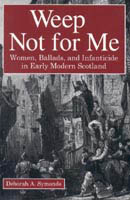 This has not been an easy book to review, for several reasons. First of all, we must consider the full title, and the subject matter: Weep Not For Me: Women, Ballads, and Infanticide in Early Modern Scotland. That’s right, Deborah Symonds, an Assistant Professor of History at Drake University, wrote a book detailing the intricate, often morbid relationships between the social situations of seventeenth- through nineteenth-century Scotland, the way women were affected, how that led — all too often — to infanticide, and how such things were ultimately immortalized in ballads.
This has not been an easy book to review, for several reasons. First of all, we must consider the full title, and the subject matter: Weep Not For Me: Women, Ballads, and Infanticide in Early Modern Scotland. That’s right, Deborah Symonds, an Assistant Professor of History at Drake University, wrote a book detailing the intricate, often morbid relationships between the social situations of seventeenth- through nineteenth-century Scotland, the way women were affected, how that led — all too often — to infanticide, and how such things were ultimately immortalized in ballads.
Not exactly the most comforting, cheering, or uplifting topic, no. And likely the sort to be interesting or useful only to diehard scholars, or those with a genuine interest in any or all of the above intertwined topics. I’ll admit that it certainly intimidated me, for quite some time. How does one approach such an esoteric work, and do it justice?
At last, though, I braved the depths of academic density, and attacked Weep Not For Me, taking some time to just sit and read it. To my surprise, what I found was a thorough and scholarly book that dealt with the subjects in a fairly accessible manner, that didn’t alienate the casual reader with dense jargon and dry words.
A brief overview of the book’s structure reveals that Symonds has been very kind to the reader, including such extras as a chronology (that lists selected events between 1688 and 1822, for both Scotland, and Britain/Europe), an introductory prologue, an appendix containing the text of the relevant ballad “Mary Hamilton,” a particularly morbid appendix detailing a list of women “investigated and/or prosecuted for infanticide, 1661-1821,” notes, bibliography, and index.
In between prologue and extras, we’re treated to chapters dealing with “Ballad Singers and Ballad Collectors,” “Ballad Heroines,” “Reconstructing Rural Infanticide,” and more, with chapters that focus on the role of women’s work during that time, the drive to make it possible to prosecute child murder, and even a look at Walter Scott’s infanticide-related novel, The Heart of Mid-Lothian.
I’ll admit it. On the surface, this book does come as a piece of scholarly research, one of those books that every professor is expected to write at least one of in their time. It makes no claims to be anything to the contrary.
Its strength is, then, the ability to attack obscure and rather touchy subjects, and to do so properly.
The book details just how alien the world of “early modern Scotland” is, compared to our own: vastly less technological, far more rural, steeped in tradition and custom, but caught in the throes of change nonetheless, both external and internal. Back then, most people lived in villages, and everyone seemed to know everyone. Marriage was expected of most people, especially if one hoped to start a family and a farm. Unfortunately, not every relationship culminated with marriage. During the several-century time period covered, illegitimate births appeared with alarming regularity, thanks to both failed courtships and the odd casual sexual encounter. And sorry to say, the resulting father didn’t always take responsibility for his part of the consequences.
Thus, single women with bastard children. Not the best thing to be, for the time and place. Is it any wonder that many of them resorted to disposing of their children, rather than be burdened with both child and stigma?
In such a manner, Weep Not For Me explores the myriad of social conditions that came together to create the Scotland of the seventeenth, eighteenth, and nineteenth centuries, a time of emerging industrialization, uncertain ties with Britain and Europe, and a greater role for women in certain elements of the workplace.
Of course, there’s also the other part of the equation, how infanticide works into ballads. Scotland’s always been a good one for producing traditional ballads, of all manner, often incorporating social commentary in the form of stories and legends. Imagine my surprise when I opened the book at random, and found “Tam Lin” quoted. Well, it -is- a story about a man who gets a woman pregnant, in order to save himself from the Fae … and the themes aren’t all that dissimilar from ones like “Mary Hamilton,” a popular ballad (found in Child, claimed to be the most popular in the collection) where the protagonist becomes pregnant, kills the child, is discovered, tried, and condemned as well.
This isn’t an uncommon theme, either, as the book further elaborates. Love, sex, murder, betrayal, occur time and time again, with only the names and exact relationships of the participants changing. The list of applicable ballads is long and startling.
It’s hard to properly describe this book, as the subject material is complex and dense. What I can say, after reading it, is that I feel a lot more knowledgeable about the topic in question, and I wasn’t traumatized by the reading. In short, this is a good book, well-written and accessible even to casual readers, that stands as a good example of how to write scholarly works for the public. It’s not easy going all the way through, nor is it exactly bathroom reading, nor is it a “tub novel.” But as a reference book, it’s outstanding. If this is a subject that interests you, be it Scottish culture and history, women’s studies, or ballads, than give it a look for yourself.
